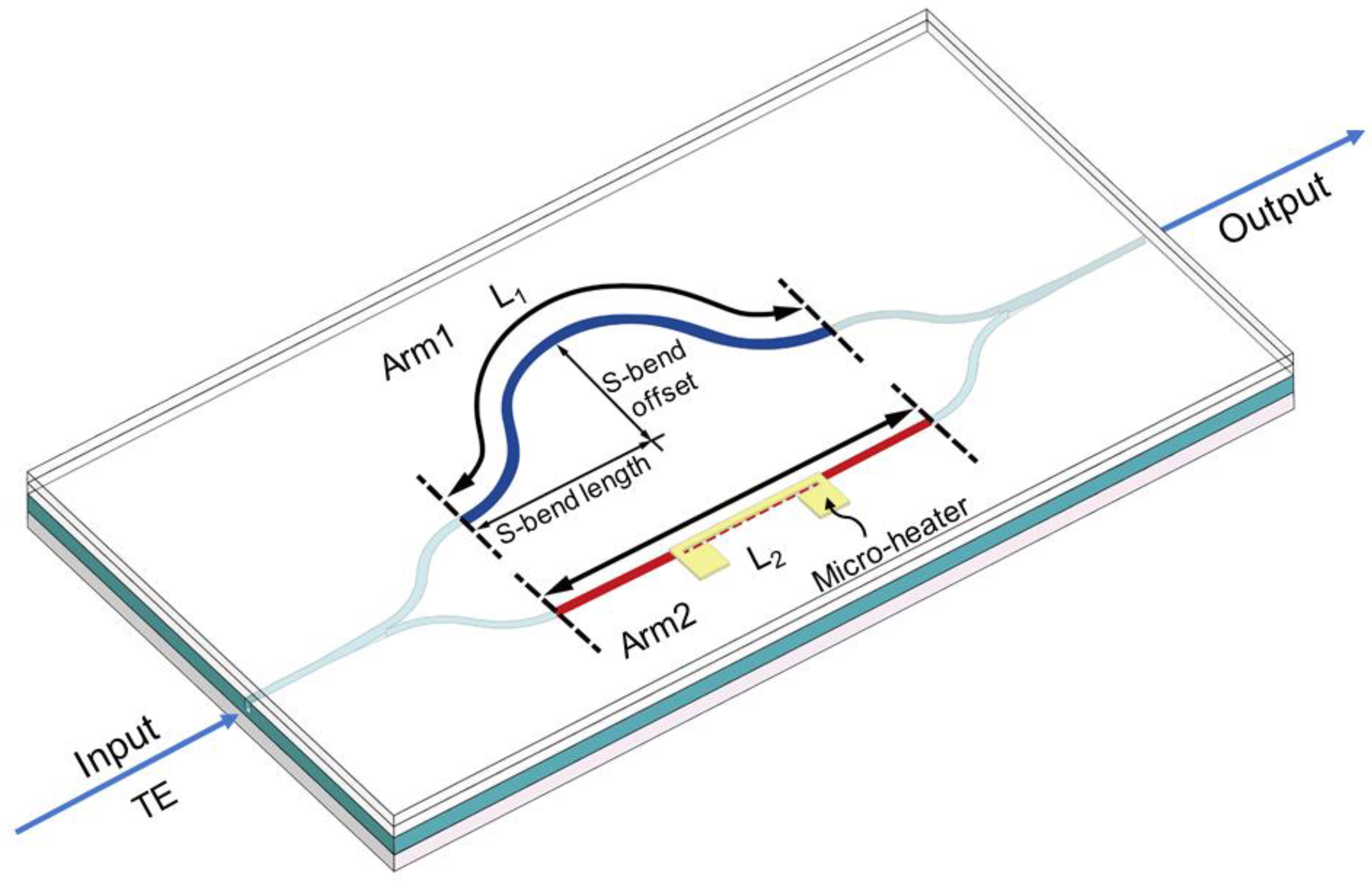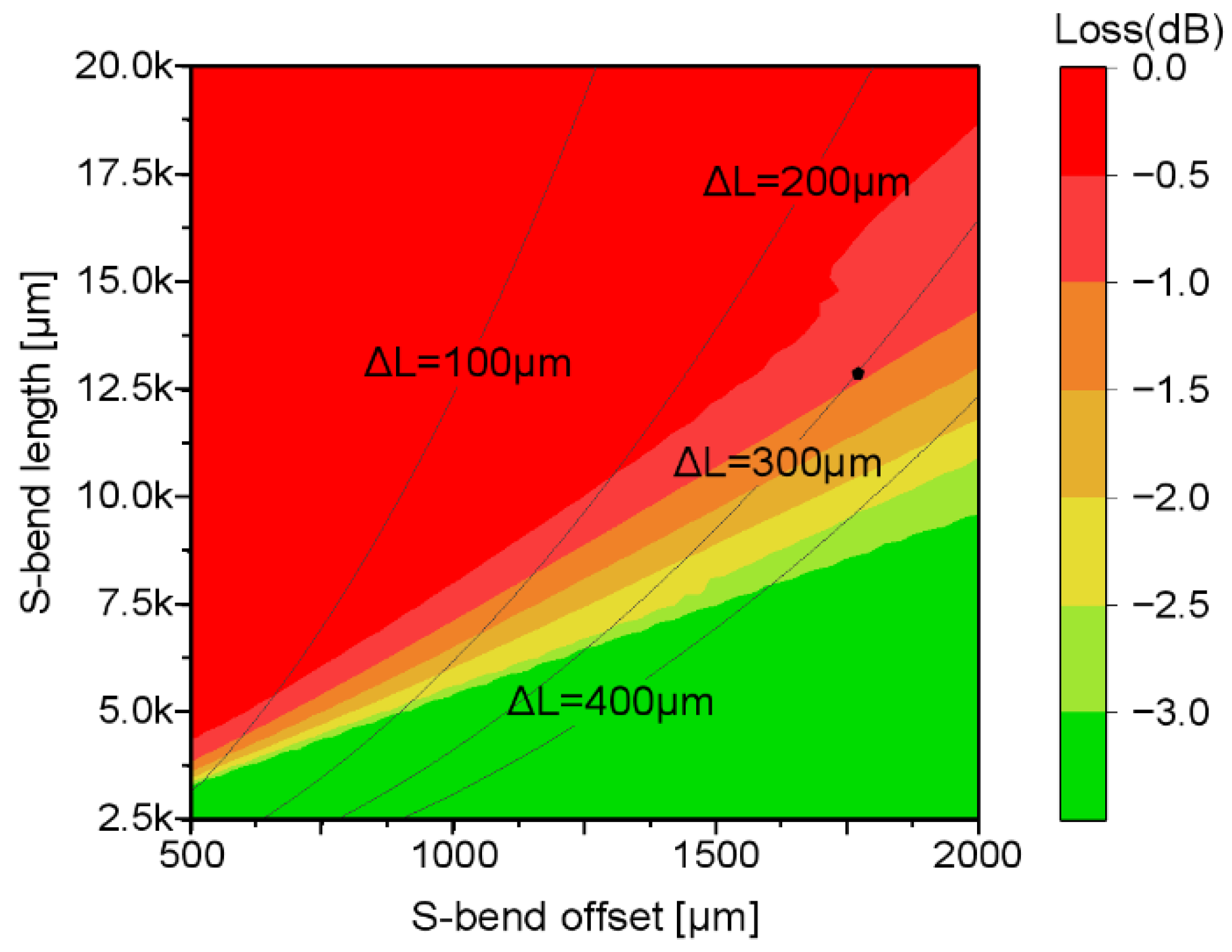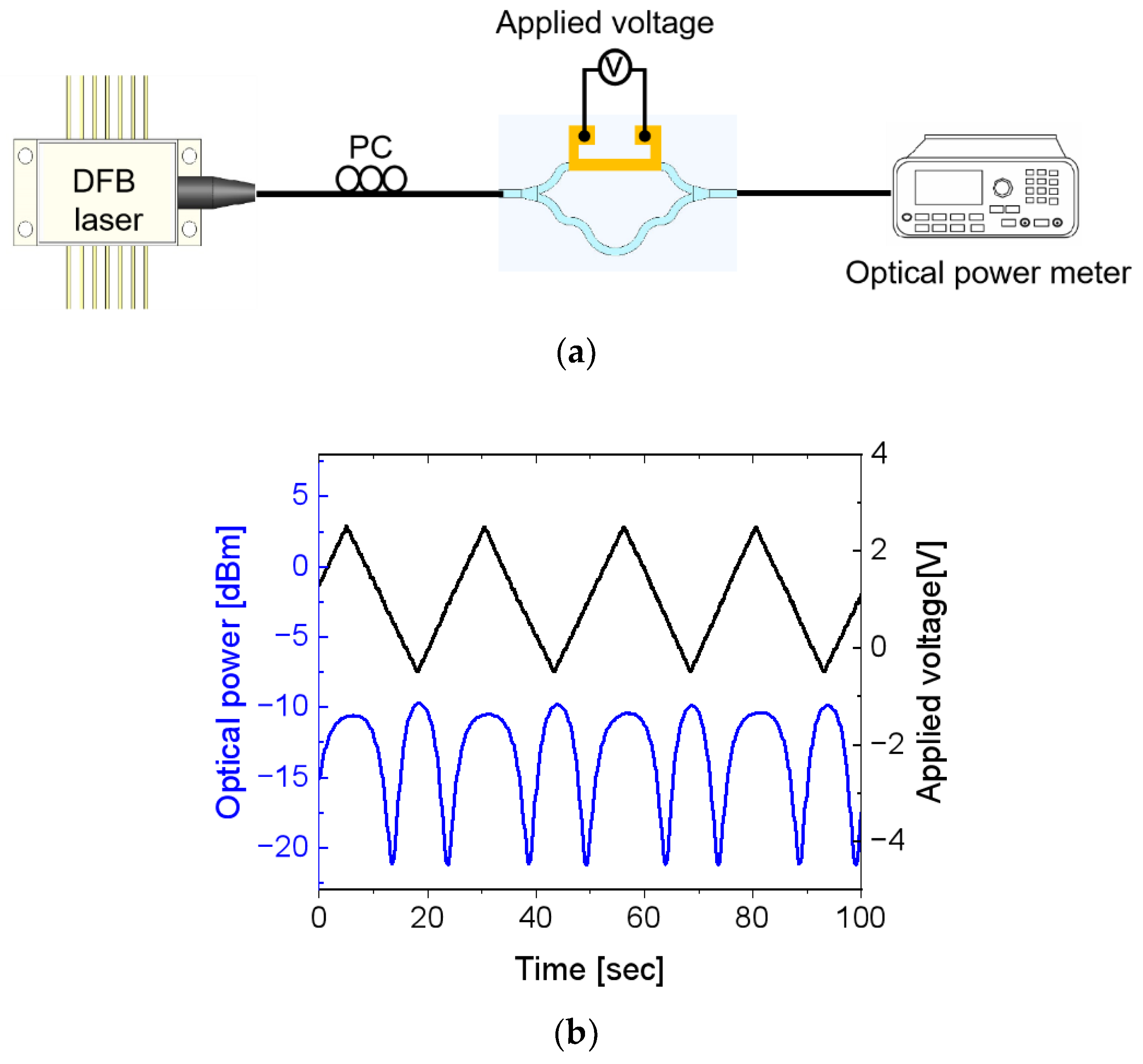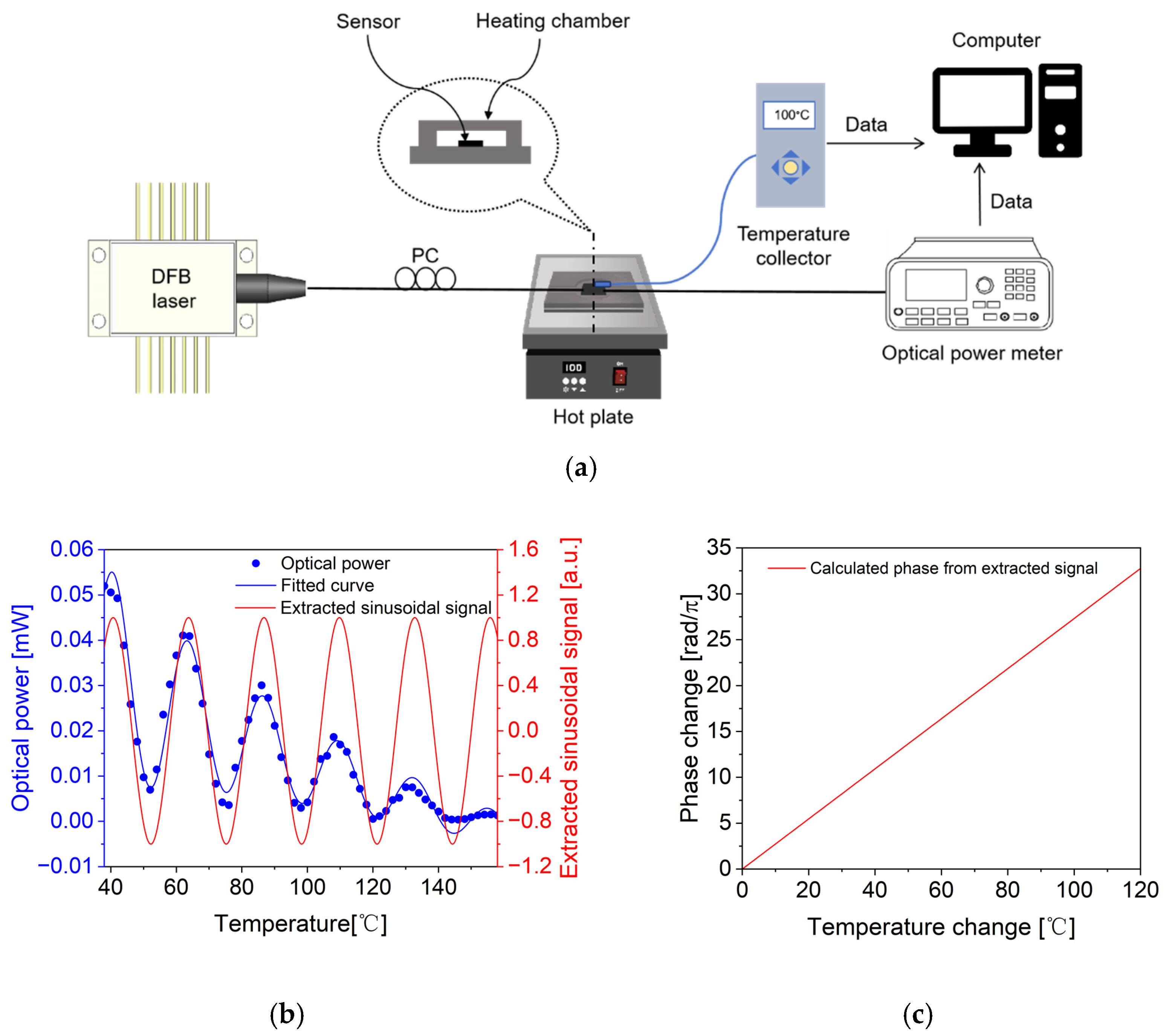Development and Characterization of an Asymmetric MZI Temperature Sensor Using Polymer Waveguides for Extended Temperature Measurement Scopes
Abstract
1. Introduction
2. Operating Principle and Device Design
3. Fabrication of the Integrated Optic Temperature Sensor
4. Characterization of the Fabricated Device
5. Conclusions
Author Contributions
Funding
Institutional Review Board Statement
Informed Consent Statement
Data Availability Statement
Conflicts of Interest
References
- Jiao, H.; Qing, C.; Li, X.; Sun, D.; Wang, L.; Zhou, Y.; Wang, K.; Feng, L. Hybrid Integrated Optical Transceiver for Interferometric Fiber-Optic Sensors. IEEE Sens. J. 2024, 24, 10188–10195. [Google Scholar] [CrossRef]
- Yao, N.; Wang, S. Recent Progress of Optical Tactile Sensors: A Review. Opt. Laser Technol. 2024, 176, 111040. [Google Scholar] [CrossRef]
- Lu, Q.; Wang, Y.; Wang, X.; Yao, Y.; Wang, X.; Huang, W. Review of Micromachined Optical Accelerometers: From Mg to Sub-Μg. Opto-Electron. Adv. 2021, 4, 200045–1–200045-24. [Google Scholar] [CrossRef]
- Zhou, J.; Wang, Y.; Zhang, G.-J. State-of-the-Art Strategies of Surface Plasmon Resonance Biosensors in Clinical Analysis: A Comprehensive Review. Coord. Chem. Rev. 2024, 520, 216149. [Google Scholar] [CrossRef]
- Bruck, R.; Melnik, E.; Muellner, P.; Hainberger, R.; Lämmerhofer, M. Integrated Polymer-Based Mach-Zehnder Interferometer Label-Free Streptavidin Biosensor Compatible with Injection Molding. Biosens. Bioelectron. 2011, 26, 3832–3837. [Google Scholar] [CrossRef]
- Chen, J.; Liu, B.; Zhang, H. Review of Fiber Bragg Grating Sensor Technology. Front. Optoelectron. 2011, 4, 204–212. [Google Scholar] [CrossRef]
- Zhang, Z.; Wang, Y.; Wang, J.; Yi, D.; Chan, D.W.U.; Yuan, W.; Tsang, H.K. Integrated Scanning Spectrometer with a Tunable Micro-Ring Resonator and an Arrayed Waveguide Grating. Photonics Res. 2022, 10, A74–A81. [Google Scholar] [CrossRef]
- Wang, Y.; Zhong, L.; Lau, K.Y.; Han, X.; Yang, Y.; Hu, J.; Firstov, S.; Chen, Z.; Ma, Z.; Tong, L. Precise Mode Control of Laser-Written Waveguides for Broadband, Low-Dispersion 3D Integrated Optics. Light Sci. Appl. 2024, 13, 130. [Google Scholar] [CrossRef]
- Wang, Q.; Ren, Z.-H.; Zhao, W.-M.; Wang, L.; Yan, X.; Zhu, A.; Qiu, F.; Zhang, K.-K. Research Advances on Surface Plasmon Resonance Biosensors. Nanoscale 2022, 14, 564–591. [Google Scholar] [CrossRef]
- El Shamy, R.S.; Khalil, D.; Swillam, M.A. Mid Infrared Optical Gas Sensor Using Plasmonic Mach-Zehnder Interferometer. Sci. Rep. 2020, 10, 1293. [Google Scholar] [CrossRef]
- Xiong, C.; Liao, C.; Li, Z.; Yang, K.; Zhu, M.; Zhao, Y.; Wang, Y. Optical Fiber Integrated Functional Micro-/Nanostructure Induced by Two-Photon Polymerization. Front. Mater. 2020, 7, 586496. [Google Scholar] [CrossRef]
- Chatzianagnostou, E.; Manolis, A.; Dabos, G.; Ketzaki, D.; Miliou, A.; Pleros, N.; Markey, L.; Weeber, J.-C.; Dereux, A.; Chmielak, B.; et al. Scaling the Sensitivity of Integrated Plasmo-Photonic Interferometric Sensors. ACS Photonics 2019, 6, 1664–1673. [Google Scholar] [CrossRef]
- Su, H.; Zhao, C.; Song, X.; Kong, F.; Zhang, Z.; Liu, C. High-Sensitivity Optical Fiber Temperature Sensor with Cascaded Configuration of MZI and FPI Based on Vernier Effect. Opt. Fiber Technol. 2021, 67, 102751. [Google Scholar] [CrossRef]
- Peng, C.; Yang, C.; Zhao, H.; Liang, L.; Zheng, C.; Chen, C.; Qin, L.; Tang, H. Optical Waveguide Refractive Index Sensor for Biochemical Sensing. Appl. Sci. 2023, 13, 3829. [Google Scholar]
- Han, J.; Wu, X.; Ge, X.; Xie, Y.; Song, G.; Liu, L.; Yi, Y. Highly Sensitive Liquid M-Z Waveguide Sensor Based on Polymer Suspended Slot Waveguide Structure. Polymers 2022, 14, 3967. [Google Scholar] [CrossRef]
- Zhao, C.; Xu, L.; Liu, L. Ultrahigh Sensitivity Mach-Zehnder Interferometer Sensor Based on a Weak One-Dimensional Field Confinement Silica Waveguide. Sensors 2021, 21, 6600. [Google Scholar] [CrossRef]
- Ma, Y.; Nghia, N.-H.; Zhou, J.; Maeda, H.; Wu, Q.; Eldlio, M.; Pistora, J.; Cada, M. Mach-Zehnder Interferometer-Based Integrated Terahertz Temperature Sensor. IEEE J. Sel. Top. Quantum Electron. 2017, 23, 4601607. [Google Scholar] [CrossRef]
- Guo, J.; Yang, C.; Dai, Q.; Kong, L. Soft and Stretchable Polymeric Optical Waveguide-Based Sensors for Wearable and Biomedical Applications. Sensors 2019, 19, 3771. [Google Scholar] [CrossRef]
- Lee, J.-M. Ultrahigh Temperature-Sensitive Silicon MZI with Titania Cladding. Front. Mater. 2015, 2, 36. [Google Scholar] [CrossRef]
- Ding, Z.; Dai, D.; Shi, Y. Ultra-Sensitive Silicon Temperature Sensor Based on Cascaded Mach–Zehnder Interferometers. Opt. Lett. 2021, 46, 2787–2790. [Google Scholar] [CrossRef]
- Payne, D.A.; Matthews, J.C. A CMOS-Compatible Heterogeneous Interferometer for Chip-Scale Temperature Sensing. Appl. Phys. Lett. 2022, 121, 261104. [Google Scholar] [CrossRef]
- Zegadi, R.; Ziet, L.; Zegadi, A. Design of High Sensitive Temperature Sensor Based on Two-Dimensional Photonic Crystal. Silicon 2020, 12, 2133–2139. [Google Scholar] [CrossRef]
- Liu, J.; Zhang, Z. Polymer-Embedding Germanium Nanostrip Waveguide of High Polarization Extinction. Polymers 2023, 15, 4093. [Google Scholar] [CrossRef]
- Xie, Y.; Chen, L.; Li, H.; Yi, Y. Polymer and Hybrid Optical Devices Manipulated by the Thermo-Optic Effect. Polymers 2023, 15, 3721. [Google Scholar] [CrossRef]
- Pudleiner, T.; Hoinkis, J.; Karnutsch, C. Analysis of Diffracted Mode Outcoupling in the Context of Amplified Spontaneous Emission of Organic Thin Films. Polymers 2024, 16, 1950. [Google Scholar] [CrossRef]
- Khan, Y.; Butt, M.A.; Khonina, S.N.; Kazanskiy, N.L. Thermal Sensor Based on Polydimethylsiloxane Polymer Deposited on Low-Index-Contrast Dielectric Photonic Crystal Structure. Photonics 2022, 9, 770. [Google Scholar] [CrossRef]
- Leal-Junior, A.; Frizera-Neto, A.; Marques, C.; Pontes, M.J. A Polymer Optical Fiber Temperature Sensor Based on Material Features. Sensors 2018, 18, 301. [Google Scholar] [CrossRef]
- Mieloszyk, M.; Majewska, K.; Andrearczyk, A. Embedded Optical Fibre with Fibre Bragg Grating Influence on Additive Manufactured Polymeric Structure Durability. Materials 2022, 15, 2653. [Google Scholar] [CrossRef]
- Lakard, B.; Carquigny, S.; Segut, O.; Patois, T.; Lakard, S. Gas Sensors Based on Electrodeposited Polymers. Metals 2015, 5, 1371–1386. [Google Scholar] [CrossRef]
- Oh, M.-C.; Chu, W.-S.; Shin, J.-S.; Kim, J.-W.; Kim, K.-J.; Seo, J.-K.; Lee, H.-K.; Noh, Y.-O.; Lee, H.-J. Polymeric Optical Waveguide Devices Exploiting Special Properties of Polymer Materials. Opt. Commun. 2016, 362, 3–12. [Google Scholar] [CrossRef]
- Niu, D.; Wang, L.; Xu, Q.; Jiang, M.; Wang, X.; Sun, X.; Wang, F.; Zhang, D. Ultra-Sensitive Polymeric Waveguide Temperature Sensor Based on Asymmetric Mach–Zehnder Interferometer. Appl. Opt. 2019, 58, 1276–1280. [Google Scholar] [CrossRef] [PubMed]
- Chen, M.-Q.; Lin, Z.-Y.; Zhao, Y. Femtosecond Laser Direct-Writing On-Chip MZI Temperature Sensor Based on Polymer Waveguides. IEEE Trans. Instrum. Meas. 2023, 72, 7007508. [Google Scholar] [CrossRef]
- Guan, X.; Wang, X.; Frandsen, L.H. Optical Temperature Sensor with Enhanced Sensitivity by Employing Hybrid Waveguides in a Silicon Mach-Zehnder Interferometer. Opt. Express 2016, 24, 16349–16356. [Google Scholar] [CrossRef] [PubMed]
- Gao, Z.; Du, Y.; Zhang, Q.; Qin, Y.; Fang, J.; Yi, Y. Silica–Polymer Heterogeneous Hybrid Integrated Mach–Zehnder Interferometer Optical Waveguide Temperature Sensor. Polymers 2024, 16, 2297. [Google Scholar] [CrossRef]
- Dullo, F.T.; Sokolov, V.; Chauvet, C.; Lindecrantz, S.; Solbø, S.A.; Hellesø, O.G. Temperature Sensitivity of Waveguide Mach-Zehnder Interferometer. In Proceedings of the Integrated Optics: Devices, Materials, and Technologies XVIII, San Francisco, CA, USA, 3–5 February 2014; SPIE: Bellingham, WA, USA, 2014; Volume 8988, pp. 419–426. [Google Scholar]





| Ref. | Materials | Year | Structure | Sensitivity (rad/°C or nm/°C) | Sensing Range (°C) | Measurement Metric |
|---|---|---|---|---|---|---|
| [31] | NOA, M-2000 | 2019 | Asymmetric MZI | 30.8 nm/°C | 3 | Wavelength |
| [32] | IP-S, PDMS | 2023 | Asymmetric MZI | 2.01 nm/°C | 40 | Wavelength |
| [33] | Silicon, SU-8 | 2016 | Asymmetric MZI | 0.172 nm/°C | 25 | Wavelength |
| [34] | PMMA, NOA SU-8 | 2024 | Asymmetric MZI | 6.85 nm/°C | 3 | Wavelength |
| [35] | Silicon, SiN | 2014 | Asymmetric MZI | 0.262 rad/°C | 10 | Phase |
| This work | LFR, ZPU | 2025 | Asymmetric MZI | 0.27 rad/°C | 120 | Phase |
Disclaimer/Publisher’s Note: The statements, opinions and data contained in all publications are solely those of the individual author(s) and contributor(s) and not of MDPI and/or the editor(s). MDPI and/or the editor(s) disclaim responsibility for any injury to people or property resulting from any ideas, methods, instructions or products referred to in the content. |
© 2025 by the authors. Licensee MDPI, Basel, Switzerland. This article is an open access article distributed under the terms and conditions of the Creative Commons Attribution (CC BY) license (https://creativecommons.org/licenses/by/4.0/).
Share and Cite
Liu, F.; Zhang, X.; Wang, T.; Huang, G. Development and Characterization of an Asymmetric MZI Temperature Sensor Using Polymer Waveguides for Extended Temperature Measurement Scopes. Photonics 2025, 12, 491. https://doi.org/10.3390/photonics12050491
Liu F, Zhang X, Wang T, Huang G. Development and Characterization of an Asymmetric MZI Temperature Sensor Using Polymer Waveguides for Extended Temperature Measurement Scopes. Photonics. 2025; 12(5):491. https://doi.org/10.3390/photonics12050491
Chicago/Turabian StyleLiu, Fumin, Xue Zhang, Tianyue Wang, and Guanghao Huang. 2025. "Development and Characterization of an Asymmetric MZI Temperature Sensor Using Polymer Waveguides for Extended Temperature Measurement Scopes" Photonics 12, no. 5: 491. https://doi.org/10.3390/photonics12050491
APA StyleLiu, F., Zhang, X., Wang, T., & Huang, G. (2025). Development and Characterization of an Asymmetric MZI Temperature Sensor Using Polymer Waveguides for Extended Temperature Measurement Scopes. Photonics, 12(5), 491. https://doi.org/10.3390/photonics12050491





